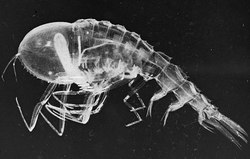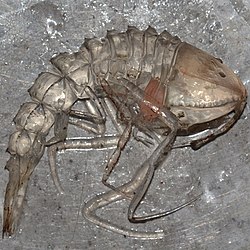| Cystisoma | |
|---|---|
 | |
| Photograph of Cystisoma in lateral view | |
 | |
| Caught C. magna specimen collected in Hawaii | |
| Scientific classification | |
| Kingdom: | Animalia |
| Phylum: | Arthropoda |
| Class: | Malacostraca |
| Order: | Amphipoda |
| Suborder: | Hyperiidea |
| Family: | Cystisomatidae Willemöes-Suhm, 1875 |
| Genus: | Cystisoma Guérin-Méneville, 1842 |
| Synonyms | |
| |
Cystisoma is a genus of amphipod. It is the only member of the family Cystisomatidae within the Hyperiidea. [1] [2] [3] [4] [5] The genus is noted for its nearly completely transparent body, adapted for life in low light waters.


